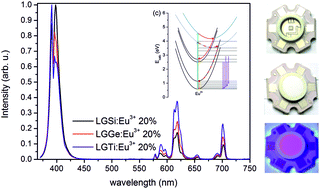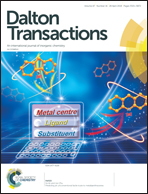Disordered langasites La3Ga5MO14 : Eu3+ (M = Si, Ge, Ti) as red-emitting LED phosphors
Abstract
Polycrystalline powders of La3Ga5SiO14 (LGSi), La3Ga5GeO14 (LGGe), and La3Ga5TiO14 (LGTi) doped with Eu3+ were studied with respect to their use as luminescent materials in solid state lighting based on light-emitting diodes. The langasites were synthesized with up to 35% of trivalent europium to achieve the highest possible doping amount. According to diffuse reflection measurements the undoped compounds have band gap energies of 4.51 eV (LGSi), 4.54 eV (LGGe) and 4.07 eV (LGTi). The luminescence behavior between 77 K and 500 K was investigated, including excitation, emission and lifetime measurements to analyze the impact of the structural differences between the three langasites on the spectroscopic properties of the materials. Depending on the excitation wavelengths, 300 nm (charge transfer) and 394 nm (4f levels, i.e.7F0 → 5L6), different quenching temperatures were achieved for LGSi : Eu3+ 20% (TQ,300 = 438 K, TQ,394 = 422 K), LGGe : Eu3+ 20% (TQ,300 = 325 K, TQ,394 = 441 K) and LGTi : Eu3+ 20% (TQ,300 = 500 K, TQ,394 = 467 K). The quenching observed can be explained by three semi-quantitative configurational coordinate diagrams. Independent from the excitation wavelength and the temperature (77–300 K) decay times of 1.1 ms were measured. At room temperature and with an excitation wavelength of 394 nm maximum quantum efficiencies of 40% for LGSi : Eu, of 80% for LGGe : Eu, and of 81% for LGTi : Eu were reached. Finally, to prove the applicability as red LED phosphors, the langasites were built into LEDs with (In,Ga)N chips emitting at 394 nm.



 Please wait while we load your content...
Please wait while we load your content...